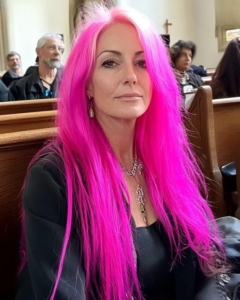This past Sunday was meant to be just another typical church day, peaceful, reflective, and full of reverence. The air was filled with the familiar sight of the crowd settling down, the faint sound of the organ warming up, and the subtle murmur of voices. I sat down as usual, not anticipating anything unusual. But then I saw a woman with bright pink hair sitting close to the front row, which caught me completely off guard.
I couldn’t believe my eyes at first. Her bold, nearly neon pink hair contrasted sharply with the subdued colors of the church’s interior design and the more traditional attire of the guests. I was drawn to the brightness as much as the color—the kind of hue you wouldn’t expect to find at a place of worship like this, but rather in a hip downtown café or an art gallery.
I was really surprised. My initial response was one of perplexity, possibly accompanied by some uneasiness. I am aware that people feel empowered to display their uniqueness in a variety of ways in our society, which values and promotes self-expression more and more. Even though I’ve always thought of myself as open-minded, it was startling to see someone at church with such a daring and unusual appearance. For me, church has always been a haven from the bustle of the outside world—a place that epitomizes humility, reverence, and peaceful contemplation. Here, faith takes precedence over fashion, and we come to connect with something bigger rather than to stand out.
I had trouble focusing when the service started. My mind kept returning to the pink-haired woman. It was more than just how she looked; it was what she stood for. Was I passing judgment? Maybe I was holding onto antiquated ideas about what church “should” look like. Throughout the sermon, I found it difficult to answer these questions. Her hair, in a sense, came to represent the greater conflict I had been experiencing over the way customs change and how hallowed places either embrace or reject the constantly shifting world beyond their borders.
I couldn’t help but observe her interacting with other attendees after the ceremony, her colorful hair becoming an integral part of her whole appearance rather as the main attraction. She was obviously as much a member of the community as anybody else, and this was simply another Sunday at church. I started to see that my response was more a result of my own expectations than of her look decision.

As I left the church that day, I couldn’t help but think that perhaps fashion or individual expression don’t take away from the sanctity of a place like a church. The variety of people who attend, each bringing their own tales, hardships, and yes, daring hairstyles to the altar, may be what strengthens it.
